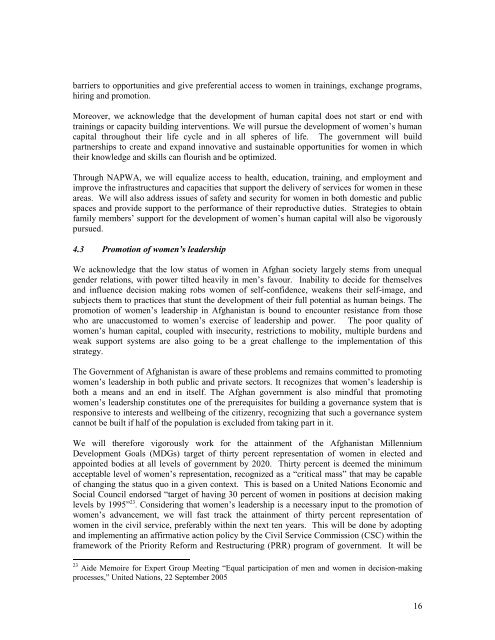National Action Plan for the Women of Afghanistan - The Secretary ...
National Action Plan for the Women of Afghanistan - The Secretary ...
National Action Plan for the Women of Afghanistan - The Secretary ...
- No tags were found...
You also want an ePaper? Increase the reach of your titles
YUMPU automatically turns print PDFs into web optimized ePapers that Google loves.
arriers to opportunities and give preferential access to women in trainings, exchange programs,<br />
hiring and promotion.<br />
Moreover, we acknowledge that <strong>the</strong> development <strong>of</strong> human capital does not start or end with<br />
trainings or capacity building interventions. We will pursue <strong>the</strong> development <strong>of</strong> women‘s human<br />
capital throughout <strong>the</strong>ir life cycle and in all spheres <strong>of</strong> life. <strong>The</strong> government will build<br />
partnerships to create and expand innovative and sustainable opportunities <strong>for</strong> women in which<br />
<strong>the</strong>ir knowledge and skills can flourish and be optimized.<br />
Through NAPWA, we will equalize access to health, education, training, and employment and<br />
improve <strong>the</strong> infrastructures and capacities that support <strong>the</strong> delivery <strong>of</strong> services <strong>for</strong> women in <strong>the</strong>se<br />
areas. We will also address issues <strong>of</strong> safety and security <strong>for</strong> women in both domestic and public<br />
spaces and provide support to <strong>the</strong> per<strong>for</strong>mance <strong>of</strong> <strong>the</strong>ir reproductive duties. Strategies to obtain<br />
family members‘ support <strong>for</strong> <strong>the</strong> development <strong>of</strong> women‘s human capital will also be vigorously<br />
pursued.<br />
4.3 Promotion <strong>of</strong> women’s leadership<br />
We acknowledge that <strong>the</strong> low status <strong>of</strong> women in Afghan society largely stems from unequal<br />
gender relations, with power tilted heavily in men‘s favour. Inability to decide <strong>for</strong> <strong>the</strong>mselves<br />
and influence decision making robs women <strong>of</strong> self-confidence, weakens <strong>the</strong>ir self-image, and<br />
subjects <strong>the</strong>m to practices that stunt <strong>the</strong> development <strong>of</strong> <strong>the</strong>ir full potential as human beings. <strong>The</strong><br />
promotion <strong>of</strong> women‘s leadership in <strong>Afghanistan</strong> is bound to encounter resistance from those<br />
who are unaccustomed to women‘s exercise <strong>of</strong> leadership and power. <strong>The</strong> poor quality <strong>of</strong><br />
women‘s human capital, coupled with insecurity, restrictions to mobility, multiple burdens and<br />
weak support systems are also going to be a great challenge to <strong>the</strong> implementation <strong>of</strong> this<br />
strategy.<br />
<strong>The</strong> Government <strong>of</strong> <strong>Afghanistan</strong> is aware <strong>of</strong> <strong>the</strong>se problems and remains committed to promoting<br />
women‘s leadership in both public and private sectors. It recognizes that women‘s leadership is<br />
both a means and an end in itself. <strong>The</strong> Afghan government is also mindful that promoting<br />
women‘s leadership constitutes one <strong>of</strong> <strong>the</strong> prerequisites <strong>for</strong> building a governance system that is<br />
responsive to interests and wellbeing <strong>of</strong> <strong>the</strong> citizenry, recognizing that such a governance system<br />
cannot be built if half <strong>of</strong> <strong>the</strong> population is excluded from taking part in it.<br />
We will <strong>the</strong>re<strong>for</strong>e vigorously work <strong>for</strong> <strong>the</strong> attainment <strong>of</strong> <strong>the</strong> <strong>Afghanistan</strong> Millennium<br />
Development Goals (MDGs) target <strong>of</strong> thirty percent representation <strong>of</strong> women in elected and<br />
appointed bodies at all levels <strong>of</strong> government by 2020. Thirty percent is deemed <strong>the</strong> minimum<br />
acceptable level <strong>of</strong> women‘s representation, recognized as a ―critical mass‖ that may be capable<br />
<strong>of</strong> changing <strong>the</strong> status quo in a given context. This is based on a United Nations Economic and<br />
Social Council endorsed ―target <strong>of</strong> having 30 percent <strong>of</strong> women in positions at decision making<br />
levels by 1995‖ 23 . Considering that women‘s leadership is a necessary input to <strong>the</strong> promotion <strong>of</strong><br />
women‘s advancement, we will fast track <strong>the</strong> attainment <strong>of</strong> thirty percent representation <strong>of</strong><br />
women in <strong>the</strong> civil service, preferably within <strong>the</strong> next ten years. This will be done by adopting<br />
and implementing an affirmative action policy by <strong>the</strong> Civil Service Commission (CSC) within <strong>the</strong><br />
framework <strong>of</strong> <strong>the</strong> Priority Re<strong>for</strong>m and Restructuring (PRR) program <strong>of</strong> government. It will be<br />
23 Aide Memoire <strong>for</strong> Expert Group Meeting ―Equal participation <strong>of</strong> men and women in decision-making<br />
processes,‖ United Nations, 22 September 2005<br />
16
















